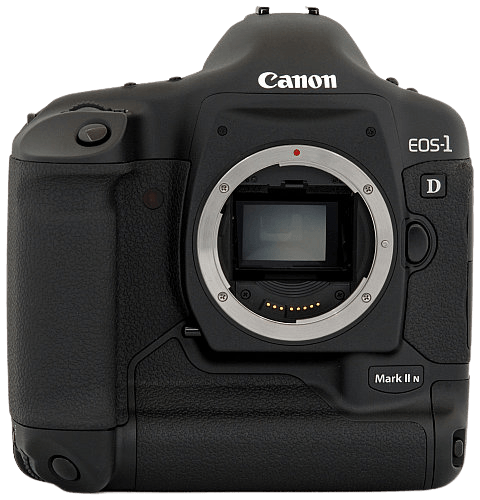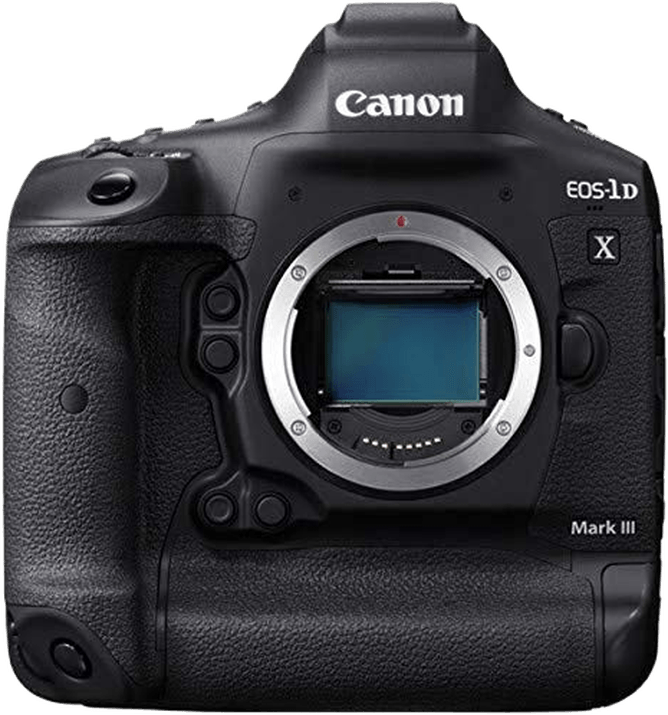Canon EOS 1D Mark II N vs EOS 1D X Mark III Comparison
Canon EOS 1D Mark II N

Canon EOS 1D X Mark III

The Canon EOS 1D X Mark III outperforms the Canon EOS 1D Mark II N with a score of 75/100 compared to 40/100. Both cameras are DSLRs and share similar dimensions, with the 1D X Mark III being slightly larger at 158 x 168 x 83mm compared to the 1D Mark II N’s 156 x 158 x 80mm. The 1D X Mark III’s higher score is due to its more advanced features and newer release date in 2020, while the 1D Mark II N was released in 2005.
The 1D X Mark III has the advantage of being significantly lighter at 738g compared to the 1D Mark II N’s 1565g. This makes it more comfortable to carry and use for extended periods. The 1D Mark II N, however, has the benefit of a lower launch price at $5986 compared to the 1D X Mark III’s $6500.
Considering the significant difference in scores and the advantages offered by the 1D X Mark III, it is the better choice for those seeking a high-performing DSLR camera. The 1D Mark II N may still be suitable for those on a tighter budget, but the 1D X Mark III’s improved specifications make it the clear winner.
Canon EOS 1D Mark II N vs EOS 1D X Mark III Overview and Optics
The Canon EOS 1D X Mark III outperforms the Canon EOS 1D Mark II N in optics, with a score of 74/100 compared to the Mark II N’s 46/100. Both cameras share some common specifications, including the use of a CMOS sensor, Canon EF lens mount, and the lack of image stabilization.
The 1D X Mark III’s superior performance is evident in its higher megapixel count (20.1 vs. 8.2), faster shooting speed (20 vs. 8.5), and improved processor (Digic X vs. Digic II). Additionally, the 1D X Mark III boasts a full-frame sensor, which typically provides better image quality and low-light performance than the APS-H sensor found in the 1D Mark II N. The 1D X Mark III’s sensor also has a higher DXOMARK score of 91, compared to the Mark II N’s score of 66, indicating better overall image quality.
While the 1D Mark II N does not surpass the 1D X Mark III in any specific optic-related features, it still offers reliable performance with its 8.2-megapixel sensor, 8.5 shooting speed, and Digic II processor. These specifications may be sufficient for some photographers, especially those on a tighter budget or with less demanding requirements.
Comparing the two cameras, the Canon EOS 1D X Mark III clearly provides better optics, with higher scores and more advanced technology. Its superior specifications make it the ideal choice for photographers seeking top-notch image quality and performance. On the other hand, the Canon EOS 1D Mark II N remains a viable option for those with less demanding needs or budget constraints, as it still delivers reliable performance in its optics.
Canon EOS 1D Mark II N vs EOS 1D X Mark III Video Performance
When comparing the video capabilities of the Canon EOS 1D Mark II N and the Canon EOS 1D X Mark III, it is important to note that the Canon EOS 1D Mark II N does not have any video functionality. This means that there is no comparison to be made in terms of video capabilities for this camera.
On the other hand, the Canon EOS 1D X Mark III has impressive video capabilities, earning a score of 91 out of 100. This camera offers a maximum video resolution of 4K, with dimensions of 4096 x 2160. Furthermore, the Canon EOS 1D X Mark III supports a maximum video frame rate of 120fps, which allows for smooth and high-quality video recording. Additionally, this camera has built-in time-lapse functionality, providing users with more creative options when capturing video.
Taking these factors into account, it is clear that the Canon EOS 1D X Mark III is the superior choice for those who require video capabilities in their camera. While the Canon EOS 1D Mark II N may have its own strengths in other areas, it is not a suitable option for capturing video. Therefore, users who prioritize video functionality should consider the Canon EOS 1D X Mark III as their preferred choice.
Canon EOS 1D Mark II N vs EOS 1D X Mark III Features and Benefits
The Canon EOS 1D X Mark III outperforms the Canon EOS 1D Mark II N with a feature score of 74/100 compared to the latter’s 17/100. Both cameras share some specifications, such as lacking a flip screen and Bluetooth connectivity.
The 1D X Mark III excels in several areas. Its screen size is larger, measuring 3.2 inches compared to the 1D Mark II N’s 2.5 inches. The screen resolution is significantly higher at 2,100,000 dots, offering a much clearer and detailed display than the 230,000 dots on the 1D Mark II N. Additionally, the 1D X Mark III has a touchscreen, making it more user-friendly and efficient. The camera also features GPS and WIFI capabilities, providing greater convenience and functionality for photographers.
The 1D Mark II N, despite scoring lower, has a few advantages over the 1D X Mark III. It is a lighter camera, which can be beneficial for photographers who need to carry their equipment for long periods. The camera also has a lower price point, making it a more affordable option for those on a tight budget.
Taking all of these factors into account, the Canon EOS 1D X Mark III is the superior camera due to its larger screen size, higher screen resolution, touchscreen, GPS, and WIFI features. The Canon EOS 1D Mark II N, although not as feature-rich, may still be suitable for photographers seeking a lighter and more affordable option.
Canon EOS 1D Mark II N vs EOS 1D X Mark III Storage and Battery
The Canon EOS 1D X Mark III outperforms the Canon EOS 1D Mark II N in storage and battery, scoring 87/100 compared to the latter’s 79/100. Both cameras share some similarities, such as having two memory card slots and lacking USB charging capabilities. However, the 1D X Mark III exhibits superior battery life, providing 2850 shots per charge with its LP-E19 battery, while the 1D Mark II N offers 1200 shots using the NP-E3 battery.
In terms of storage, the 1D X Mark III utilizes CFexpress Type B memory cards, while the 1D Mark II N relies on SD and Compact Flash (Type I or II) cards. The 1D Mark II N’s compatibility with multiple card types could be considered an advantage, as it offers users more options and flexibility.
Ultimately, the Canon EOS 1D X Mark III’s impressive battery life and storage capacity make it a superior choice in this comparison. However, the Canon EOS 1D Mark II N still holds value with its compatibility with various memory card types.
Canon EOS 1D Mark II N vs EOS 1D X Mark III – Our Verdict
Are you still undecided about which camera is right for you? Have a look at these popular comparisons that feature the Canon EOS 1D Mark II N or the Canon EOS 1D X Mark III:

